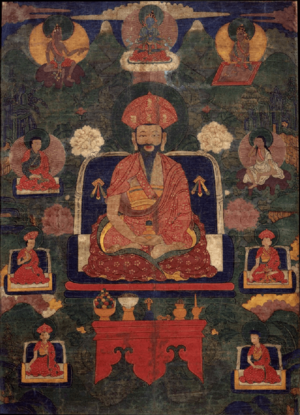Ngawang Namgyal facts for kids
Ngawang Namgyal (born 1594, died 1651) was a very important Buddhist leader from Tibet. People later called him Zhabdrung Rinpoche, which means "at whose feet one submits." He is famous for uniting the country of Bhutan and creating its unique culture. Before him, different parts of Bhutan were often fighting. He brought them together in the 1630s. He also made sure Bhutan had its own special identity, different from Tibetan culture.
Contents
His Early Life and Becoming a Leader
Ngawang Namgyal was born in Ralung Monastery in Tibet. His father was a leader of the Drukpa Lineage, a type of Tibetan Buddhism. His family was very important in this lineage.
When he was young, Ngawang Namgyal became the leader of Ralung Monastery. People believed he was the new form of a very wise Buddhist master named Kunkhyen Pema Karpo.
However, not everyone agreed with this. Another group supported a different person as the new leader. This caused some disagreements and problems in Tibet. Even so, Ngawang Namgyal remained the rightful leader of Ralung Monastery because of his family's history.
Moving from Tibet to Bhutan
Later, Ngawang Namgyal had a problem with a powerful leader in Tibet. This leader demanded that Ngawang Namgyal give up important religious items.
To avoid being arrested and to find a safer place, Ngawang Namgyal left Tibet in 1616. He had visions that told him Bhutan would be a good home. He moved to western Bhutan and started building new centers there. He built Cheri Monastery in the Thimphu valley.
In 1629, he built Simtokha Dzong. A dzong is a special type of fortress and monastery. This dzong helped him control who traveled between the important Paro valley and the eastern parts of Bhutan.
Uniting Bhutan
Zhabdrung Rinpoche worked to bring western Bhutan under his control. He brought together different groups that had been fighting for a long time. He built more dzongs, like Punakha Dzong, which helped him unite the country. Eventually, he brought all of Bhutan together. He allowed some older Buddhist groups, like the Nyingma sect, to continue their practices in central and eastern Bhutan. Today, his own group, the Southern Drukpa Lineage, is the main state religion of Bhutan.
In 1627, the first Europeans visited Bhutan. They were two Jesuit priests from Portugal. They found Zhabdrung to be a kind and smart host. He was full of energy and loved art and writing. He was also very spiritual and had just finished a three-year silent meditation. He was happy to have the visitors but did not want them to leave. He even offered to help them build churches. But the Jesuits wanted to continue their journey to Tibet.
Bhutan's Unique Government
Zhabdrung also created Bhutan's special way of governing. It's called the dual system of government. This system shares power between two main leaders. One leader, called the Je Khenpo, is in charge of religious matters. The other leader, called the Druk Desi, handles the country's everyday government affairs. This system, though changed a bit, is still used in Bhutan today.
Connections with Ladakh
Sengge Namgyal, a ruler of Ladakh (a region near Tibet and Bhutan), was a big supporter of Zhabdrung's Buddhist group. Ladakh also had problems with the new government in Tibet.
Ladakh invited Zhabdrung Ngawang Namgyal to be their state priest. But Zhabdrung was busy uniting Bhutan and dealing with attacks from Tibet. So, he sent a representative named Choje Mukzinpa to Ladakh. Bhutan was given some religious lands in Ladakh. One of these places, Stakna Monastery, became an important center for Zhabdrung's Buddhist tradition in Ladakh. This monastery still has old items and papers from Bhutan.
His Passing
Zhabdrung Ngawang Namgyal passed away in 1651. After his death, the local governors, called penlops, took control. They worried that if people knew he had died, there would be fighting and chaos again. So, they decided to keep his death a secret for 54 years! During this time, they gave orders in his name, saying he was on a very long, silent meditation retreat.
Today, the anniversary of Zhabdrung's death is a national holiday in Bhutan. It is celebrated on the tenth day of the third month of the Bhutanese calendar.
See also
 In Spanish: Shabdrung Ngawang Namgyal para niños
In Spanish: Shabdrung Ngawang Namgyal para niños


